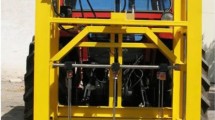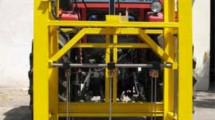Abstract
This study explores capability of adaptive neuro-fuzzy interface system (ANFIS) model for soil erosion assessment of which various parameters are involved and the parameters interaction is highly nonlinear. Soft computing technique has been applied widely in various fields, but its application in soil science is limited. A number of models have been established in predicting soil erosion such as a revised universal soil loss equation (RUSLE) model whereby parameters of the RUSLE model are employed in testing the ANFIS model in this study. Besides, a new parameter of biomass microbe (Mf) is introduced and its effectiveness in controlling erosion is demonstrated. A hilly area near the Guthrie Corridor Expressway, Malaysia, is chosen as a study area whereby five experimental plots size of 8 × 8 m and 5 × 5 m are developed. These five plots are characterized by either natural or planted vegetation or either with or without microbe bio-fertilizer. Input parameters of RUSLE, i.e. rainfall erosivity, soil erodibility, slope length and steepness, vegetation and support practice, are measured, and observed erosion is monitored for 1 year. The microbe factor presented as Mf is examined by pairing the plot with and without microbe while keeping other similar characteristic for those plots. Result shows a satisfactory achievement between observed and predicted model by ANFIS with R2, RMSE and MAE being 0.8275, 1.4276 and − 0.0165, respectively. In terms of a relationship between the Mf factor and soil erosion, it is noticed that the soil erosion is inversely proportional to the Mf when the entire erosion conservation practices are unchanged for a given period. Therefore, the application of microbes could be an alternative or additional erosion conservation technique in soil conservation works.










Similar content being viewed by others
References
Adham M, Shirazi S, Othman F, Rahman S, Yusop Z, Ismail Z (2014) Runoff potentiality of a watershed through SCS and functional data analysis technique. Sci World J. https://doi.org/10.1155/2014/379763
Aghdam IN, Varzandeh MHM, Pradhan B (2016) Landslide susceptibility mapping using an ensemble statistical index (Wi) and adaptive neuro-fuzzy inference system (ANFIS) model at Alborz Mountains (Iran). Environ Earth Sci 75:1–20
Anagu I, Ingwersen J, Utermann J, Streck T (2009) Estimation of heavy metal sorption in German soils using artificial neural networks. Geoderma 152:104–112
Azamathulla HM, Chang CK, Ghani AA, Ariffin J, Zakaria NA, Hasan ZA (2009) An ANFIS-based approach for predicting the bed load for moderately sized rivers. J Hydro Environ Res 3:35–44
Beskow S, Mello C, Norton L, Curi N, Viola M, Avanzi J (2009) Soil erosion prediction in the Grande River Basin, Brazil using distributed modeling. CATENA 79:49–59
Bhattarai R, Dutta D (2007) Estimation of soil erosion and sediment yield using GIS at catchment scale. Water Resour Manag 21:1635–1647
Bizuwerk A, Taddese G, Getahun Y (2008) Application of GIS for Modeling Soil Loss Rate in Awash Basin, Ethiopia. International Livestock Research Institute (ILRI), Addis Ababa, Ethiopia
Celik I (2005) Land-use effects on organic matter and physical properties of soil in a southern Mediterranean highland of Turkey. Soil Tillage Res 83:270–277
Cevik A, Ozturk S (2009) Neuro-fuzzy model for shear strength of reinforced concrete beams without web reinforcement. Civ Eng Environ Syst 26:263–277
Ceylan M, Arslan M, Ceylan R, Kaltakci M, Ozbay Y (2010) A new application area of ANN and ANFIS: determination of earthquake load reduction factor of prefabricated industrial buildings. Civ Eng Environ Syst 27:53–69
Chen T, Niu R-Q, Li P-X, Zhang L-P, Du B (2011) Regional soil erosion risk mapping using RUSLE, GIS, and remote sensing: a case study in Miyun Watershed, North China. Environ Earth Sci 63:533–541
Dabral P, Baithuri N, Pandey A (2008) Soil erosion assessment in a hilly catchment of North Eastern India using USLE, GIS and remote sensing. Water Resour Manag 22:1783–1798
Dai X, Huo Z, Wang H (2011) Simulation for response of crop yield to soil moisture and salinity with artificial neural network. Field Crops Res 121:441–449
De Franchis L, Ibanez F (2003) Threats to soils in Mediterranean Countries. Plan Bleu-Centre d’activités régionales, Sophia Antipolis
Demirci A, Karaburun A (2012) Estimation of soil erosion using RUSLE in a GIS framework: a case study in the Buyukcekmece Lake watershed, northwest Turkey. Environ Earth Sci 66:903–913
Fu B, Zhao W, Chen L, Zhang Q, Lu Y, Gulinck H, Poesen J (2005) Assessment of soil erosion at large watershed scale using RUSLE and GIS: a case study in the Loess Plateau of China. Land Degrad Dev 16:73–85
Hammad AA, Haugen LE, Børresen T (2004) Effects of stonewalled terracing techniques on soil-water conservation and wheat production under Mediterranean conditions. Environ Manag 34:701–710
Huang Y, Lan Y, Thomson SJ, Fang A, Hoffmann WC, Lacey RE (2010) Development of soft computing and applications in agricultural and biological engineering. Comput Electron Agric 71:107–127
Jain SK, Kumar S, Varghese J (2001) Estimation of soil erosion for a Himalayan watershed using GIS technique. Water Resour Manag 15:41–54
Jang J-S, Sun C-T (1995) Neuro-fuzzy modeling and control. Proc IEEE 83:378–406
Kalkan E, Akbulut S, Tortum A, Celik S (2009) Prediction of the unconfined compressive strength of compacted granular soils by using inference systems. Environ Geol 58:1429–1440
Khalilmoghadam B, Afyuni M, Abbaspour K, Jalalian A, Dehghani A, Schulin R (2009) Estimation of surface shear strength in Zagros region of Iran—a comparison of artificial neural networks and multiple-linear regression models. Geoderma 153:29–36
Kinnell P (2014) Geographic variation of USLE/RUSLE erosivity and erodibility factors. J Hydrol Eng C4014012:1–7
Kisi O, Haktanir T, Ardiclioglu M, Ozturk O, Yalcin E, Uludag S (2009) Adaptive neuro-fuzzy computing technique for suspended sediment estimation. Adv Eng Softw 40:438–444
Kouli M, Soupios P, Vallianatos F (2009) Soil erosion prediction using the revised universal soil loss equation (RUSLE) in a GIS framework, Chania, Northwestern Crete, Greece. Environ Geol 57:483–497
Lai SH, Law PL, Mah DYS (2008) Applications of GIS and remote sensing in the hydrological study of the upper Bernam river Basin, Malaysia. Inst Eng, Malaysia 69(1):13–18
Lal R (2001) Soil degradation by erosion. Land Degrad Dev 12:519–539
Lal R (2003) Soil erosion and the global carbon budget. Environ Int 29:437–450
Mashrei MA, Abdulrazzaq N, Abdalla TY, Rahman M (2010) Neural networks model and adaptive neuro-fuzzy inference system for predicting the moment capacity of ferrocement members. Eng Struct 32:1723–1734
Minasny B, Hopmans J, Harter T, Eching S, Tuli A, Denton M (2004) Neural networks prediction of soil hydraulic functions for alluvial soils using multistep outflow data. Soil Sci Soc Am J 68:417–429
Naderloo L, Alimardani R, Omid M, Sarmadian F, Javadikia P, Torabi MY, Alimardani F (2012) Application of ANFIS to predict crop yield based on different energy inputs. Measurement 45:1406–1413
Onyando J, Kisoyan P, Chemelil M (2005) Estimation of potential soil erosion for river perkerra catchment in Kenya. Water Resour Manag 19:133–143
Pahlavan R, Omid M, Akram A (2012) Energy input–output analysis and application of artificial neural networks for predicting greenhouse basil production. Energy 37:171–176
Paudel D, Thakur JK, Singh SK, Srivastava PK (2014) Soil characterization based on land cover heterogeneity over a tropical landscape: an integrated approach using earth observation data-sets. Geocarto Int 30:218–241. https://doi.org/10.1080/10106049.2014.905639
Ramedani Z, Omid M, Keyhani A (2012) A method based on neural networks for generating solar radiation map. Int J Energy Environ 3:775–786
Renard KG, Foster GR, Weesies GA, Porter JP (1991) RUSLE: revised universal soil loss equation. J Soil Water Conserv 46:30–33
Renard K, Foster G, Weesies G, McCool D, Yoder D (1997a) Predicting soil loss by water: a guide to conservation planning with the revised soil loss equation (RSULE). Handbook, vol. 703. US Department of Agriculture, Washington, DC
Renard KG, Foster GR, Weesies GA, McCool D, Yoder D (1997) Predicting soil erosion by water: a guide to conservation planning with the revised universal soil loss equation (RUSLE). Agriculture Handbook (Washington)
Schaap MG, Leij FJ (1998) Using neural networks to predict soil water retention and soil hydraulic conductivity. Soil Tillage Res 47:37–42
Shirazi SM, Adham I, Othman F, Zardari NH, Ismail Z (2016) Runoff trend and potentiality in Melaka Tengah catchment of Malaysia using SCS-CN and statistical technique. J Environ Eng Landsc Manag 24:245–257
Silva RB, Iori P, Armesto C, Bendini HN (2010) Assessing rainfall erosivity with artificial neural networks for the Ribeira Valley, Brazil. Int J Agron 2010:1–7
Singh R, Kainthola A, Singh T (2012) Estimation of elastic constant of rocks using an ANFIS approach. Appl Soft Comput 12:40–45
Sobhani J, Najimi M, Pourkhorshidi AR, Parhizkar T (2010) Prediction of the compressive strength of no-slump concrete: a comparative study of regression, neural network and ANFIS models. Constr Build Mater 24:709–718
Tay J-H, Zhang X (1999) Neural fuzzy modeling of anaerobic biological wastewater treatment systems. J Environ Eng 125:1149–1159
Tayfur G (2002) Artificial neural networks for sheet sediment transport. Hydrol Sci J 47:879–892
Tew KH (1999) Production of Malaysian soil erodibility nomograph in relation to soil erosion issues: VT Soil Erosion Research and Consultancy
Uno Y, Prasher S, Lacroix R, Goel P, Karimi Y, Viau A, Patel R (2005) Artificial neural networks to predict corn yield from Compact Airborne Spectrographic Imager data. Comput Electron Agric 47:149–161
Valipour M (2013) Increasing irrigation efficiency by management strategies: cutback and surge irrigation. ARPN J Agric Biol Sci 8:35–43
Valipour M (2014) Application of new mass transfer formulae for computation of evapotranspiration. J Appl Water Eng Res 2:33–46
Valipour M (2015) Study of different climatic conditions to assess the role of solar radiation in reference crop evapotranspiration equations. Arch Agron Soil Sci 61:679–694
Valipour M (2016) How much meteorological information is necessary to achieve reliable accuracy for rainfall estimations? Agriculture 6:53
Valipour M, Montazar AA (2012) An evaluation of SWDC and WinSRFR models to optimize of infiltration parameters in furrow irrigation. Am J Sci Res 69:128–142
Valipour M, Sefidkouhi MAG, Raeini M (2017) Selecting the best model to estimate potential evapotranspiration with respect to climate change and magnitudes of extreme events. Agric Water Manag 180:50–60
Wang G, Hapuarachchi P, Ishidaira H, Kiem AS, Takeuchi K (2009) Estimation of soil erosion and sediment yield during individual rainstorms at catchment scale. Water Resour Manag 23:1447–1465
Weifeng Z, Bingfang W (2008) Assessment of soil erosion and sediment delivery ratio using remote sensing and GIS: a case study of upstream Chaobaihe River catchment, north China. Int J Sedim Res 23:167–173
Wischmeier W, Smith D (1978a) Predicting rainfall erosion losses. Agricultural handbook 537. Agricultural Research Service, United States Department of Agriculture
Wischmeier W, Smith D (1978b) Predicting rainfall erosion losses. USDA agricultural research services handbook 537. USDA, Washington, DC 57
Wischmeier WH, Johnson CB, Cross BV (1971) Soil erodibility nomograph for farmland and construction sites. J Soil Water Conserv 26:189–193
Yilmaz I, Yuksek G (2009) Prediction of the strength and elasticity modulus of gypsum using multiple regression, ANN, and ANFIS models. Int J Rock Mech Min Sci 46:803–810
Yue-Qing X, Xiao-Mei S, Xiang-Bin K, Jian P, Yun-Long C (2008) Adapting the RUSLE and GIS to model soil erosion risk in a mountains karst watershed, Guizhou Province, China. Environ Monit Assess 141:275–286
Zhang Y, Degroote J, Wolter C, Sugumaran R (2009) Integration of modified universal soil loss equation (MUSLE) into a GIS framework to assess soil erosion risk. Land Degrad Dev 20:84–91
Acknowledgements
The authors would like to acknowledge the University of Malaya for overall financial support and the PROLINTAS Expressway Sdn. Bhd., Malaysia, for allowing this study to use their Guthrie Corridor Expressway (GCE) slopes as experimental site. This research was carried out by the University of Malaya Research Grant (UMRG) under the project “Investigate Soil Hydrological Aspects and Vegetation Cover for Slope Erosion” Project No. PR005B-13SUS and the Ministry of Higher Education Grant of FRGS Project No. FP039-2014B.
Author information
Authors and Affiliations
Corresponding author
Rights and permissions
About this article
Cite this article
Islam, M.R., Jaafar, W.Z.W., Hin, L.S. et al. Development of an intelligent system based on ANFIS model for predicting soil erosion. Environ Earth Sci 77, 186 (2018). https://doi.org/10.1007/s12665-018-7348-z
Received:
Accepted:
Published:
DOI: https://doi.org/10.1007/s12665-018-7348-z




